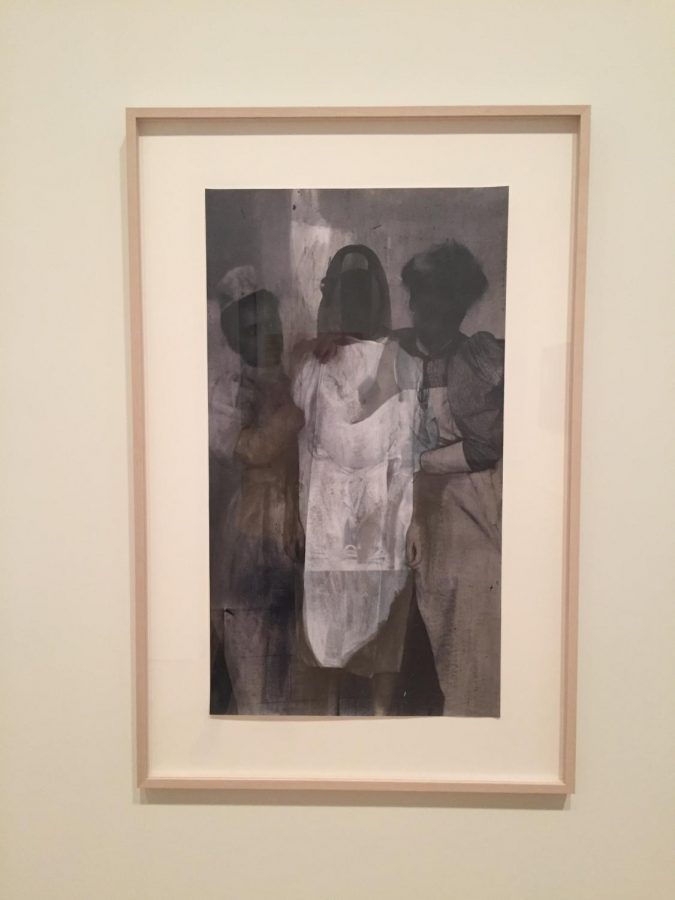Masterful art on display at Wash U thesis exhibition
Published May 14, 2018
Every year I see the MFA Thesis exhibition at the Mildred Lane Kemper Art Museum, and every year I’m impressed with the quality of work. The current exhibition, “MFA18,” is no exception. I decided to focus on two artists instead of three because I wanted to delve into the multiple layers that make up their work.
Cecily Fergeson’s four mixed-media drawings (each 53” x 34 ¾”), titled “Four Sights of the Patient (Ophelia),” explore the history of the relationship between the medical profession and patients. Fergeson created digital collages by combining archival medical photographs with pictures she took of a model wearing a modern hospital gown. The medical photographs belong to the collection of the Mütter Museum in Philadelphia.
She explains, “I was interested in how medical photography has captured a record of the medical gaze – a term that refers to the doctor’s view of the patient as a diagnosis more than a person – and how these photographs have affected the way we look at and behave as patients.”
In three of the four drawings, two nurses in late 19th– or early 20th-century uniforms hold the arms of a female patient standing between them. The faces of all three women are obscured. The fourth drawing depicts a face which is only partly visible.
The artist explains, “In the early-to-mid-twentieth century, medical photographers began to crop around the affected body part or put black bars over the patients’ eyes to hide their identities and preserve dignity. To be a patient is to be vulnerable. I obscure[ed] the faces of the caregivers and patients, because…my work attempts to reclaim these bodies and re-shroud them. [I hoped to make] these images of medical conditions and situations, often seen as frightening curiosities because of their age, objects to be looked into rather than at.”
Fergeson collaged historical and contemporary photographs in order to show a continuation of the way in which the medical profession (and healthy people) view patients. The resulting superimposed images also evoke the idea of ghosts—the caregivers, after all, died long ago.
Her work as a whole refers to the drowning of Ophelia in Hamlet. Fergeson considers the drowning “ambiguous [because] I wanted to point to how easy it is to sink into the world of the medical institution, especially for patients with chronic illnesses, but that this sinking remains a choice. Ophelia lets herself sink – it isn’t clear whether she intends to die or whether this was an accident.”
The repetition, monochromatic palette, and questions about identity present in Fergeson’s work also drew me to Brent Nakamoto’s three oil-on-canvas paintings: “Osamu Shimada, La Selva Beach,” “Donald Yamamoto, La Selva Beach,” and “Earl Santo, La Selva Beach,” each 64” x 44.”
Nakamoto’s grayscale paintings reproduce photographs, taken in 1948, which his grandmother owned. Each portrays a Japanese-American teenager on a beach. He doesn’t know the identities of the boys beyond their names, and is trying to locate them and/or their families.
The artist said, “I was drawn to these because the figures have such a unique energy—I want to know more about them. I see some of myself in them. As a mixed Japanese-American, I have complicated feelings about my own cultural identity, as well as the way my family’s identity has changed through immigration and internment during World War Two.”
He made only one change to the images: partially or fully painting out each boy’s face. This act of “defacement,” to use his term, is complex in and of itself.
“In part it comes from this desire to connect…with the [boys]…and the way this desire is denied,” he says. “[It’s] denied in part because of the nature of the photograph—it shows something that no longer exists.”
He continues, “I don’t want to…appropriate[e] their image and story in order to make any kind of personal political statement. The defacement is a way of acknowledging the difficult relationship between desire and denial. [All] people bear the scars of their past, and these scars only become more evident as we continue looking back.”
“MFA18” is on view at the Mildred Lane Kemper Art Museum through May 21. The museum is located on Washington University’s Danforth campus near the corner of Skinker and Forsyth. Visitors may park in Forest Park or in the DUC garage on Forsyth at Wallace Drive. Museum hours are Wednesday – Monday, 11:00 a.m. – 5:00 p.m.; and closed Tuesdays. For more information, call 314-935-4523 or visit www.kemperartmuseum.wustl.edu/.















